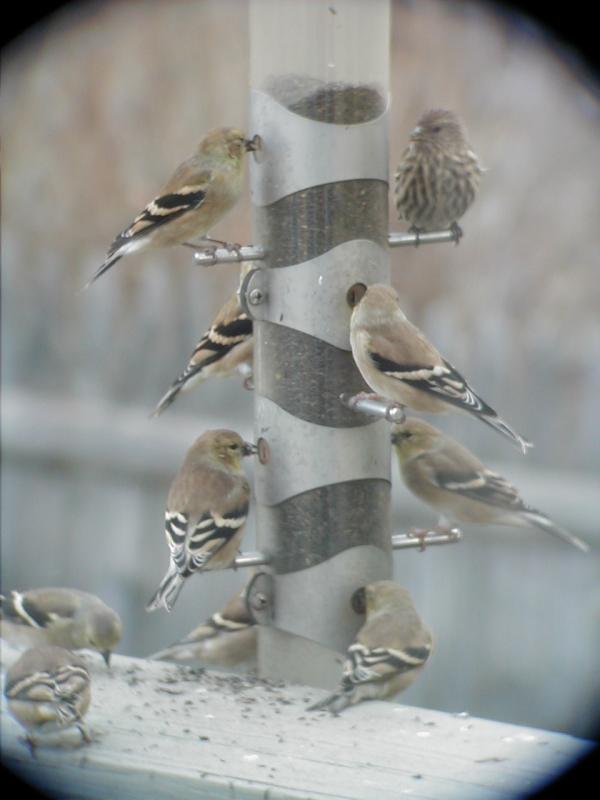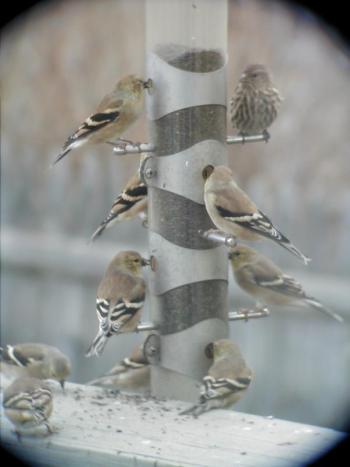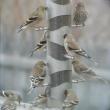Gifts for the birds
Now that Thanksgiving is behind us and the mayhem of Black Friday (if you buy into such schemes) has “cashiered” in the official gift-giving season, why not change it up a bit by thinking of “gifts” for the birds?
For us, the recent snow storm (not to mention the news from buried Buffalo, New York) are great reasons to evaluate our bird-feeding station in preparation for the months ahead. And that has inspired us to share few tips for people like us who enjoy feeding our feathered friends.
Black-oil sunflower seeds. If you had to choose one offering, we recommend this. It’s packed with protein and thin-shelled, making it a favorite among some of Maine’s feeder birds, including cardinals, chickadees, nuthatches and titmice. Offer it in a hanging tube feeder or spread it on a platform out of neighborhood cats’ reach.
Nyjer. You may know this as "thistle" seed (though it’s not actually related to our native thistle plants).
Nyjer is best served in a tube feeder designed for these tiny seeds, so they don’t spill out. It’s a favorite among finches — house finches, purple finches, goldfinches (this time of year, look for them in their drabber olive-green plumage, as the males’ flashy golden garb has long molted away). Any pine siskins and common redpolls that happen to be in the area may be attracted to your nyjer feeder as well.
Millet. This tiny, round grain is a favorite among juncos and sparrows. Sprinkle it on the ground in an area protected from prowling neighborhood cats. The birds will always perch on a platform for a millet meal.
Corn. If you’ve ever wanted a visit from a flock of wild turkeys, corn is your best bet. Turkeys and ducks prefer it whole; doves, sparrows, and blue jays prefer it cracked. Corn and millet are a great seed mix to attract a variety of species; sprinkle in a protected area on the ground or on a platform feeder.
To lure in the sunflower seed lovers, you can mix in some black-oil sunflower seeds as well — it’s great to see a platform bustling with birds feasting together.
Mixed seed. Skip it! Cheap bags of mixed seed are often made up disproportionately of milo, reddish colored grain that very few eastern species will eat. Better to spend a few pennies more and make your own seed mix than to fill a feeder full of shunned seeds.
Suet. A suet feeder is a must for all woodpecker enthusiasts. Downy and hairies will quickly become regular guests, as will any roaming red-bellied woodpeckers (an increasingly common bird here in Maine) and quite possibly the occasional pileated. Songbirds such as chickadees and nuthatches will also help themselves.
Remember to clean your feeders about every two weeks by washing them in soapy water and rinsing them in a solution of one part bleach to nine parts water. Dry your feeders completely before refilling them. Rake the ground as seed waste starts to pile up, to keep it from molding.
Now, we’re often asked about whether feeding birds teaches them bad habits by making them reliant on a hand out. The answer is no. Despite how it may seem, birds actually get just a small portion of their diet from feeders. On the other hand, a feeding station can help birds through tough times, like snow and ice storms.
So plan now for these “gifts for birds” that will be enjoyed for months to come — by the birds, and by you!
Event Date
Address
United States




































